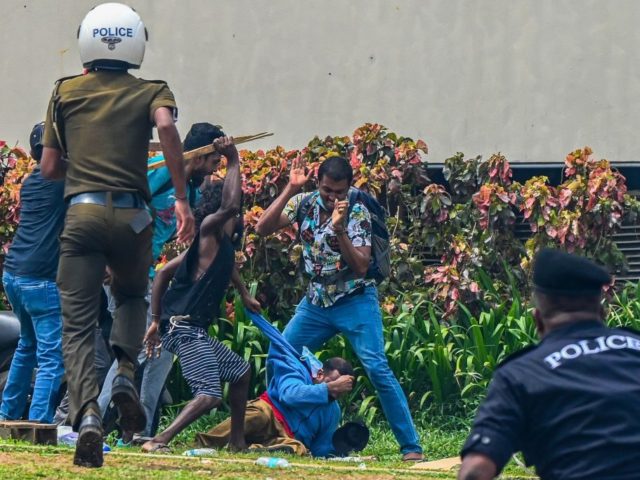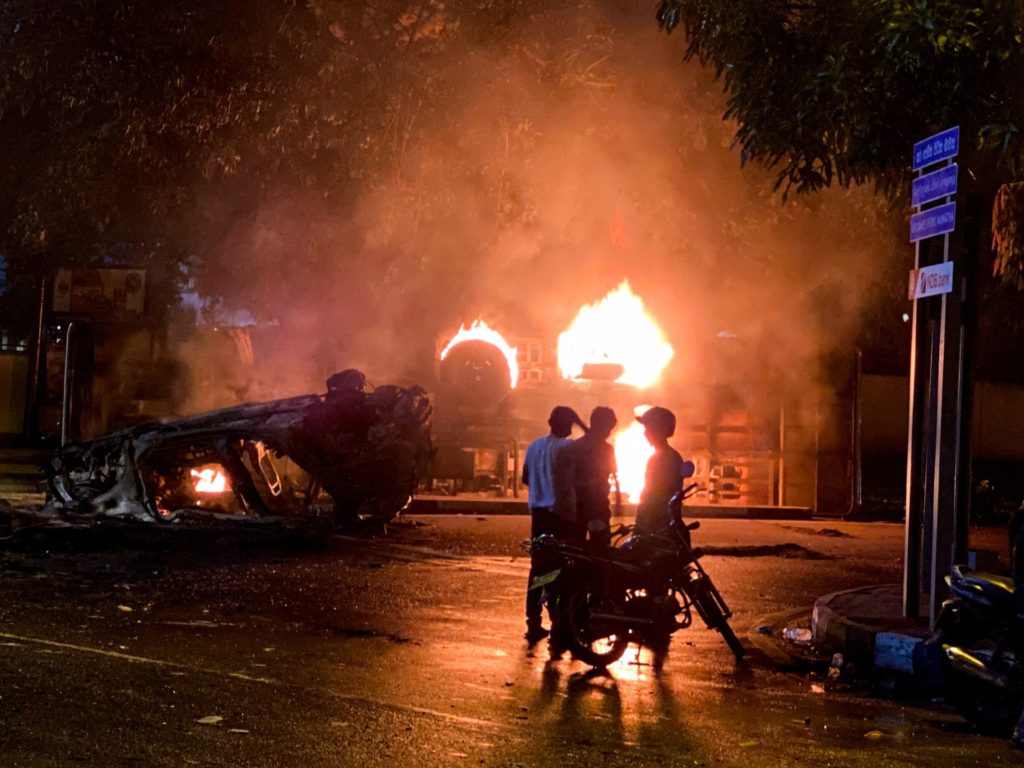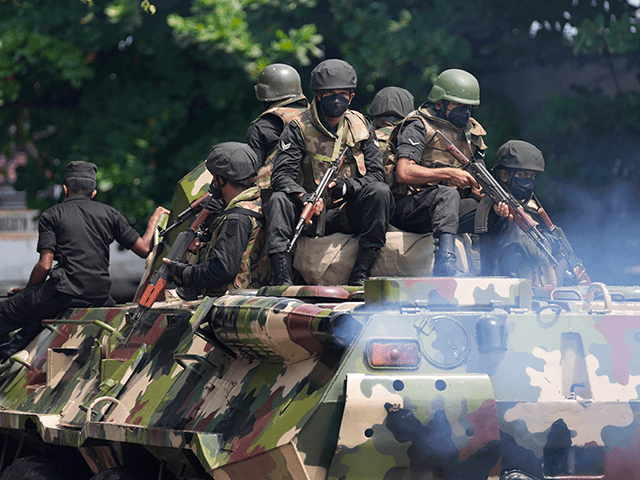The Sri Lankan Defense Ministry on Tuesday ordered its forces to “shoot all those who plunder public property or cause personal harm” as riots swept across the island, causing at least eight deaths and leaving more than a hundred houses burned.
Sri Lankan authorities said the eight fatalities included a member of parliament and several police officials. Mobs destroyed or damaged 88 vehicles in addition to the burned homes. Most of the vandalized property belonged to current or former parliamentarians from the ruling party.
The legislator who died, Amarakeerthi Athukorala, reportedly opened fire on a mob that surrounded his car, critically injuring two of them. The rest of the mob chased him down and killed him while he tried to hide in a nearby building. Some reports claim he committed suicide.
The arsonists and vandals were spurred by rumors that members of the ruling party were quietly fleeing Sri Lanka with their families and seeking refuge in India. The Indian High Commission issued a statement from its office in the Sri Lankan capital of Columbo on Tuesday denying these rumors.
Defense Secretary Kamal Gunaratne announced on Wednesday that “stern action” would be taken against rioters, arsonists, and looters regardless of their party affiliation. He said CCTV footage would be used to hunt down offenders, and confirmed his troops have been given shoot-on-sight orders for curfew violators.
Another statement, issued by Army General Shavendra Silva, denounced rumors spread by opposition leaders that the Sri Lankan military plans to open fire on the public to provoke more intense riots, giving the government a pretext to impose complete martial law. Silva vowed none of his soldiers would “resort to any such disgraceful acts under any circumstances.”
The crisis in Sri Lanka, a democratic socialist country, began in March with massive demonstrations against the island’s dismal economy. Angry crowds demanded the resignation of the president and prime minister, who happen to be brothers, Gotabaya and Mahinda Rajapaksa.
The Rajapaksas clung stubbornly to power, unsuccessfully trying to form a “unity government” with opposition leaders. The economy grew steadily worse, leading Sri Lanka to default on its $51 billion in external debt in April. Meanwhile, the streets grew violent as supporters of the Rajapaska family clashed with protesters.
On Monday, dozens of Rajapaksa supporters attacked protesters camped outside the presidential office, touching off the worst violence of the crisis and leading to curfews enforced by the military.

Demonstrators and government supporters clash outside the official residence of Sri Lanka’s Prime Minister Mahinda Rajapaksa, in Colombo on May 9, 2022. (ISHARA S. KODIKARA/AFP via Getty Images)
Prime Minister Mahinda Rajapaksa resigned on Monday, along with all members of the Cabinet – one of whom was his son, Youth Minister Namal Rajapaksa.
The departing prime minister asked all parties to step back from violent confrontations while an interim government is formed:
The PM’s peaceable rhetoric was met with considerable skepticism by the protesters, who noted the mob of thugs that attacked demonstrators on Monday launched their attack by pouring out of Mahinda Rajapaksa’s house.

A bus burns close to Sri Lanka’s outgoing Prime Minister Mahinda Rajapaksa’s official residence, in Colombo May 9, 2022. (ISHARA S. KODIKARA/AFP via Getty Images
Central Bank Governor Nandalal Weerasinghe on Wednesday predicted the national economy was only two days away from total collapse unless a new government is installed to take drastic action. Security officials feared “total anarchy” in the streets.

People walk past a burnt bus near Sri Lanka’s former prime minister Mahinda Rajapaksa’s official residence, a day after it was torched by protesters in Colombo on May 10, 2022. (ISHARA S. KODIKARA/AFP via Getty Images)
Mahinda’s younger brother Gotabaya remained in office as of Wednesday, facing international human rights criticism for his declared state of emergency and shoot-on-sight curfew orders. The protesters are unlikely to be satisfied with any “interim government” that includes him, while the remaining Rajapaksa has the police, military, and his street army of club-wielding supporters standing by to keep him in power.

Police use a water canon to disperse university students protesting to demand the resignation of Sri Lanka’s President Gotabaya Rajapaksa over the country’s crippling economic crisis, near the parliament building in Colombo on May 6, 2022. (ISHARA S. KODIKARA/AFP via Getty Images)
“We’re concerned by the deployment of the military. We underscore, we stress that peaceful protesters should never be subject to violence or intimidation, whether that’s on the part of a military force or civilian unit,” U.S. State Department spokesman Ned Price said on Tuesday.
“The government must address the Sri Lankan people’s discontent over the economic crisis, including power, food, and medicine shortages, as well as their concerns about the political future of their country,” Price said.
President Rajapaksa made his first address to the nation in over a month on Wednesday, offering a compromise in which he would surrender many of his executive powers, but would continue to preside over a “unity government.”
“I will name a prime minister who will command a majority in parliament and the confidence of the people,” Rajapaksa pledged.
President Rajapaksa dismayingly chose to portray the protests against him as motivated by racism, religious bigotry, and “subversive” elements – thus overlooking his central bank governor’s warning that by the end of the week, there might not be anything left to subvert:
Gotabaya Rajapaksa came to power riding a wave of Sinhalese Buddhist populism and public demands for strong national security in the wake of the horrific Easter Sunday church bombings of 2019.
The wave was big enough to carry two of Gotabaya’s brothers and two of his nephews into the Cabinet after his August 2020 election victory. Mahinda was himself president from 2005 to 2015, and would probably have resumed the perch if a constitutional two-term limit had not been imposed on the top office, so he settled for prime minister.
There were five Rajapaksas in the Cabinet counting Gotabaya, who named himself defense minister in violation of the Sri Lankan constitution. Mahinda, meanwhile, was named finance, urban development, and Buddhist affairs minister in addition to taking the prime minister’s seat.
The eldest Rajapaksa brother, Chamal, took over the ministries of irrigation, internal security, home affairs, and disaster management (the nephews were modestly limited to one Cabinet seat apiece, due to their youth).
Mahinda apparently found it difficult to hold both the prime minister and finance minister positions, because he surrendered the latter in 2021. Luckily, he had yet another brother named Basil standing by to pick up the slack.
The economic crisis that might finally knock the Rajapaksa clan from power was greatly exacerbated by the Wuhan coronavirus pandemic, Russia’s invasion of Ukraine, and the economic shocks unleashed by those major international events, but the root of Sri Lanka’s problems was simple economic mismanagement on a breathtaking scale.
The Rajapaksas borrowed and spent stupendous amounts of money, including on some extremely unwise Chinese-funded Belt and Road infrastructure projects. They surrounded themselves with cronies, silenced the opposition with the help of state media, and used ethnic and religious appeal to put muscle on the streets when needed. Sri Lanka’s foreign currency reserves tapped out in March, the island was convulsed with food shortages and rolling blackouts, and the illusion of a functioning government came crashing down.

COMMENTS
Please let us know if you're having issues with commenting.